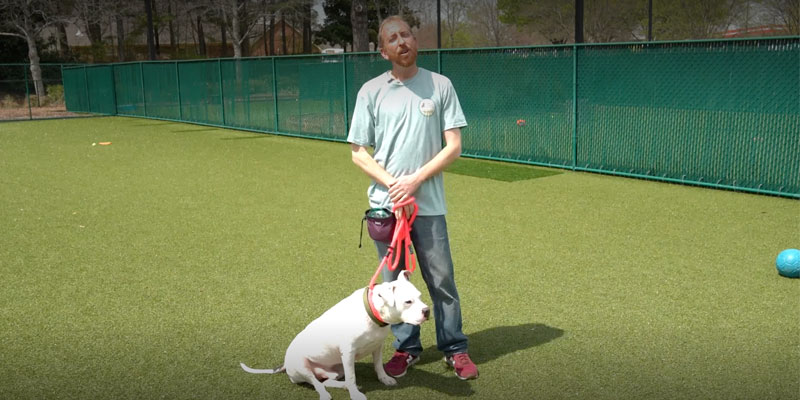We’ve partnered with Barking Hound Village to provide training resources for pet owners who need assistance. Learn more about preventing rude behavior in your dog by watching the video and reading the training guide below.

Young and energetic dogs have a number of ways to interact and play that may appear rude and over-the-top to their human family and friends. Dogs aren’t born with the knowledge that we don’t like these behaviors. In fact, the opposite is true. Dogs, like all social animals, develop early rough play as an important part of their social development. It’s why you’re far more likely to see a couple of 10-year-old kids wrestling on the ground than you will a couple of 40-year-old adults. Instead of getting frustrated with your dog when they are doing what comes natural, take the time to properly teach your dog how you do and do not want them to behave.
The foundation of teaching your dog how to properly interact is simple: ignore the rude behavior and reward the appropriate behavior. The key to success is consistency. Your dog is learning throughout every single interaction. If you reinforce the rude behavior some of the time, even if you didn’t mean to, and even if it’s only rarely, you are teaching your dog it’s OK to do the behavior some of the time. And some of the time to a dog means that they can try it every time.
In situations when you know your dog’s energy and adrenaline will be higher than normal, such as when you come home after being away or guests come over to visit, it’s important to be proactive by getting in front of the impending rude behavior.
Coming in with treats can teach your dog to sit, even without telling them to. Many dogs will “default” into a sit when they know you have a tasty treat, especially if you slowly lift it above their head. When you walk in the door and see a blur of fur headed your way, hold the treat out in front of you, let your dog smell it, and then slowly bring it up to your chest. If the treat is valuable enough – the stinkier the better – most dogs, many of whom have already been taught to sit for a treat, will offer that sit automatically.
The more you practice, the more likely your dog will be to sit for you when you first walk in the door. All they wanted in the first place was your attention. Once they reliably start offering the appropriate behavior, you won’t need to continue giving them treats. Your love and attention will be all you need to continue reinforcing the good behavior.
For guests, controlling your dog during the initial greeting can help prevent unwanted behavior while you teach them what you do want. It also gives your dog time to clear the adrenaline from their bodies that surges when they first hear a knock or doorbell.
When someone that your dog has met before is coming over and you know the guest will receive lots of jumping and other rude behavior, put your dog on a leash before the guest comes inside. After the guest enters, stand still with your dog and don’t let them pull forward. Tell your guest to approach once your dog is calmly standing, sitting, or lying down, and to stop if your dog gets excited, jumps, or barks. The guest can begin approaching again once your dog returns to a calm stand, sit, or down. If your dog remains in one of these calm positions, the guest can approach and give them all of the love they want. And if your dog jumps, nips, or barks while the guest is saying hello to them, your guest can take a big step back, out of your dog’s reach, and wait for your dog to resume a calm position before they step forward and continue the greeting. If you consistently practice this each time a guest comes over, your dog will learn to become calm more quickly and, eventually, they will know exactly what they need to do if they want to say hello to a guest.
Now, if you’re thinking to yourself, ‘what do I do with my dog for the rest of the visit?’ then I want you to ask yourself what you would do with a 3-year-old child. Would you expect that child to sit quietly while you and your guest talk and sip tea? Of course not. You would interact with that child or give that child something to interact with. Puppies and young dogs are no different. Providing interesting and high-value distractions, like chew and treat-dispensing toys, allows your dog to continue getting their play energy out with the guests nearby and without needing the guests to interact with them.
Ultimately, the best thing you can do is take the time to train your dog in a calm, controlled environment and then build the strength of the appropriate behaviors to the point where they will work in distracting situations, like dinner with the in-laws. Remember, dogs don’t come pre-programmed. Teach them when they’re young and you’ll never have to teach them again.
If your dog is excitable, over-the-top, and unable to keep themselves from jumping and displaying other rude behavior, Barking Hound Village can help! With private, one-on-one training sessions at your home, group training classes at 3 locations around metro-Atlanta, including the West Midtown Atlanta Humane Society location, and our 2-week intensive Board-and-Train program, Barking Hound Village has the perfect training service to fit your exact needs. Visit their website or contact them at (404)-369-2014 or training@barkinghoundvillage.com.

